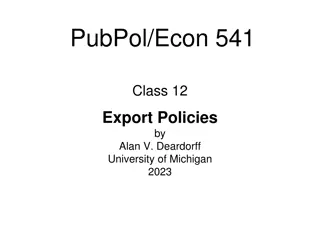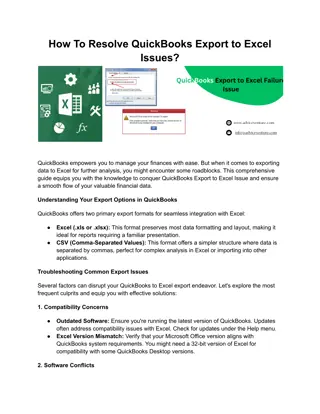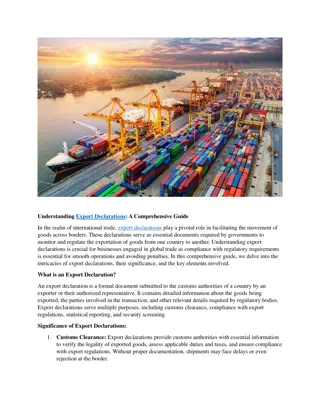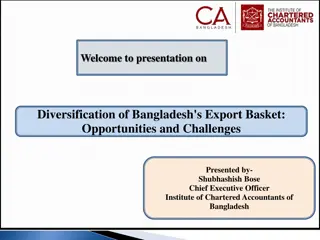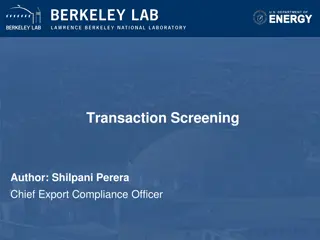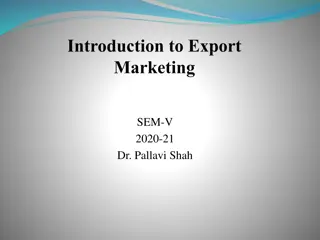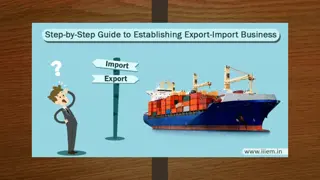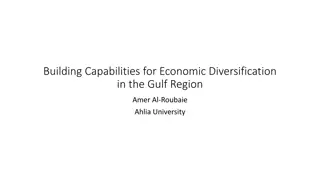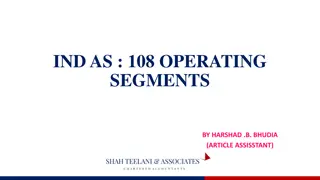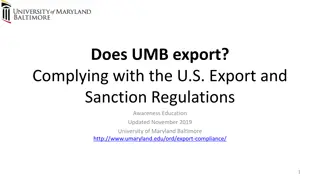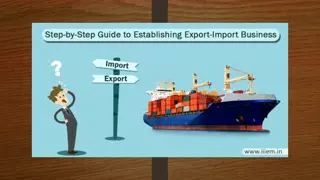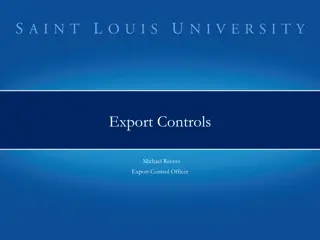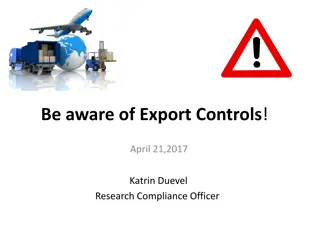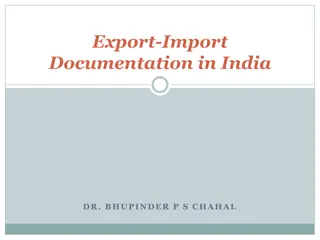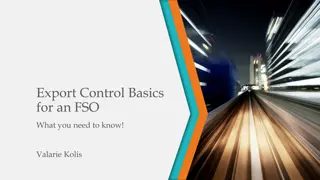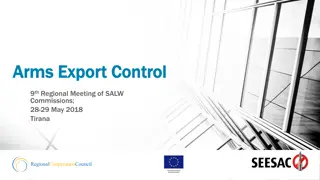
Unlocking Pakistan's Manufacturing Export Potential
Explore how Pakistan can overcome economic challenges by diversifying its manufacturing exports. Learn about global best practices, Pakistan's current export landscape, challenges hindering diversification, and strategies for growth amidst systemic biases.
Download Presentation

Please find below an Image/Link to download the presentation.
The content on the website is provided AS IS for your information and personal use only. It may not be sold, licensed, or shared on other websites without obtaining consent from the author. If you encounter any issues during the download, it is possible that the publisher has removed the file from their server.
You are allowed to download the files provided on this website for personal or commercial use, subject to the condition that they are used lawfully. All files are the property of their respective owners.
The content on the website is provided AS IS for your information and personal use only. It may not be sold, licensed, or shared on other websites without obtaining consent from the author.
E N D
Presentation Transcript
| Introduction The objective of this report is to identify potential non-traditional export sectors within manufacturing for short to medium-term growth. Pakistan's economy faces significant challenges, including low growth rates ranging between 2-3%, coupled with persistently high inflation averaging 25% and record-high interest rates reaching 22%. These economic difficulties are a result of structural weaknesses, which were exacerbated by the catastrophic floods in 2022, supply chain disruptions due to Covid-19 pandemic, global recession impacts, and domestic political uncertainty. Pakistan's export basket has remained undiversified and low in complexity, primarily concentrated on textile and agricultural products. The manufacturing sector reflects these challenges, experiencing a notable 3.94% decrease in growth during FY23, alongside a stagnant investment-to-GDP ratio at 14%.
|Export Diversification Global Best Practices Export diversification reduces economic vulnerability and fosters growth by minimizing dependency on a few products. Three stages of export diversification include Shifting from a few primary commodities to a larger variety of products, Transitioning to manufacturing exports, and Expand exports into tertiary sectors like communication services. Between 2005 and 2020, Pakistan s global export share declined from 0.19% to 0.16%. Successful export-oriented policies in Korea, Taiwan, and China shifted economies from agriculture to competitive manufacturing, leading to middle-and high-income status. Bangladesh's export-led industrialization led to impressive growth, specially in ICT Policies supporting export-oriented sectors, such as tax exemptions, contributed to Bangladesh's economic success.
| Pakistans case of Inadequate Diversification Pakistan's total exports in 2021 were USD 36.7 billion, ranking 63 out of 133 countries, with a predominantly undiversified export basket of textiles, rice, and ICT. The complexity of Pakistan's export basket is low, with major exports in moderate and low complexity categories, such as textiles and agriculture. Export growth has primarily come from less complex products like apparel and knitwear, with limited growth in more complex sectors like pharmaceuticals and medical apparatus. Over the past 15 years, Pakistan has introduced only 26 new products to its export basket. Most Pakistani exports are in non-competitive sectors, with declining global growth, and only a few products are in competitive regions. Pakistan's export destinations are limited, with small shares beyond the US and China. Significant export potential exists in the EU, North America, East Asia, and Southeast Asia, requiring focused diplomatic trade missions and compliance with new EU sustainability requirements by 2025.
| Challenges to Pakistans Export Diversification Higher tariffs and complicated tariff structures along with manufacturers' easy access to the large domestic market contribute to systemic anti-export bias. The disproportionately high returns offered by sectors like real estate, wholesale & retail have diverted investment away from manufacturing Significant structural issues hamper business environment, including i. policy inconsistency ii. legal issues and gaps iii. inadequate institutional governance iv. low savings rate v. vi. a sizable informal economy vii. weak dispute settlement mechanisms. shallow financial markets Pakistani firms struggle to integrate into global value chains due to a lack of scale, quality, and compliance with global standards. Compliance issues and inadequate certifications hinder market access, with new EU regulations adding challenges, while limited export financing for SMEs restricts growth. Negotiations of FTAs and PTAs have yielded limited benefits. An appreciated and volatile exchange rate also impacts export competitiveness.
| Identifying Potential Export Diversification Three methodologies are used to identify potential export diversification sectors: trade data analysis, Hausmann product space analysis, and the GIFF Framework. The top exports are textiles and agriculture, with seven key manufactured export sectors identified for potential diversification, excluding primary agriculture, fisheries, and natural resource-based sectors. Pakistan's export sectors have a total unrealized potential of USD 3.73 billion, nearly 10% of the country's total exports in fiscal year 2022. Sector-Specific Insights: In Textiles (HS 6302), Pakistan excels in subcategories like knitted bed linen but lags in printed bed linen. In Men's Apparel (HS 6203 & 6103), Pakistan has strong presence in cotton ensembles but minimal in wool and synthetic fiber suits. In Knitted Sweaters (HS 6110), Pakistan has significant share in knitted articles but modest in cotton and synthetic fiber sweaters. In Saddlery (HS 4201), Pakistan is dominant in saddlery but underperforming in the global market compared to Vietnam. In Luggage (HS 4202), Pakistan has noticeable share in handbags but untapped potential in other leather containers.
| Unrealized Export Potential by Products Product HS Code Unrealized Export Potential (USD) Primary Export Potential Products Bed, Table, Toilet, and Kitchen Linen 6302 2.1 billion Linen Men s or Boys Suits and Apparel 6203 512 million Men s trousers Men s trousers, cotton shorts knitted or crocheted. Men s or Boys Knitted Apparel 6103 226 million Knitted Sweaters and similar Articles 6110 99 million Knitted or crocheted jerseys Saddlery and Harness for Any Animal 4201 8.2 million Trunks, Suitcases, Vanity cases, Briefcases, and Similar containers 4202 23.6 million Handbags of leather composition Apparel and Clothing Accessories 4203 489 million Articles of leather apparel Yarn (other than sewing thread) of synthetic staple fibers 5509 8.1 million Synthetic staple fiber yarn Medical or Surgical Instruments and Apparatus Microscopes other than optical microscopes 90 307.9 million Toys, Games, and Sports requisites 95 393.9 million Inflatable balls
| Hausmann Product Space Analysis The Hausmann Product Space analysis suggests possible diversification avenues for Pakistan based on current capabilities. Short-term opportunities include furniture, synthetic textiles and garments, surgical instruments, footwear, food processing, and electronics assembly. Medium-term prospects encompass steel, non-ferrous metals, electronics, mining, and pharmaceuticals. Long-term strategic bets involve platform-changing value chains, IT, clean technology, electrical machinery, and autonomous vehicles. Focus areas identified for this paper are synthetics, surgical and medical devices, leather footwear and products, and pharmaceuticals.
| Growth Identification and Facilitation Framework The Growth Identification and Facilitation Framework (GIFF) combines market effectiveness with government facilitation to drive industrial diversification. The first step of the GIFF is to identify potential countries from whom the share in products can be transferred. Benchmark countries are identified based on GDP per capita growth, manufacturing value added, and minimum wage criteria. Bangladesh, China, Indonesia, Viet Nam are the shortlisted benchmarked countries. Bangladesh emerges as an ideal country for transferring nitrogenous mineral or chemical fertilizers. China stands out as an ideal destination for transferring garments, footwear, data processing machines, and toys (such as puzzles and reduced-size models). Viet Nam is identified as an ideal country for transferring garments and parts and accessories for office machines. Indonesia is highlighted as an ideal country for transferring footwear and data processing machines.
| Export Diversification Sectors Overview Five potential sectors for export diversification are identified: i. High-Value Garments, ii. Leather Products & Footwear, iii. Surgical & Medical Devices, iv. Sporting Goods, and v. Pharmaceuticals. Stakeholder interviews were conducted with key industry representatives to gather insights into each sector's potential and challenges. Interviews included representatives from garment manufacturing, surgical instrument production, leather and garment exports, pharmaceuticals, and sporting goods manufacturing. Interviews were conducted via phone calls to accommodate time and mobility constraints, lasting 15-20 minutes each. Each interview focused on sector overview, obstacles, and opportunities for export diversification within the respective industries.
| Ready-Made Garments (RMG) sector The Ready-Made Garments (RMG) sector in Pakistan, primarily dominated by SMEs, faces challenges hindering its growth and export diversification. These challenges are as follows: Sub-optimal supply chains present a hurdle to expanding into new markets and product lines. Limited access to newer materials, such as man-made and technology yarns, impedes progress. Below-par cotton yield, quality, and variety also contribute to the sector's limitations. Higher input costs and reduced reliability compared to competitor countries hinder development. Limited access to credit, coupled with high transaction costs, adds to the challenges. Barriers in transitioning to renewable (solar) energy, pose additional obstacles. Fluctuating exchange rates complicate pricing strategies, hindering diversification efforts. Under the EU Green Deal, compliance with sustainability regulations offers diversification opportunities but requires substantial investments. Recommendations include expanding the Export Facilitation Scheme (EFS), developing communal infrastructure, improving trade and customs facilitation, enhancing market knowledge, fostering international connections, rationalizing solar energy costs, relaxing financing requirements, and incentivizing compliance service providers.
| Leather Product and Footwear sector The leather product and footwear industry in Pakistan lacks development in associated industries such as designing and leather shaping, constraining exports and diversification. Skill development is crucial for the industry, but Pakistan struggles to produce skilled worker needed due to a gap between manufacturers and training institutes. The ban on 3-D printers also restricts design innovation in the industry, hindering progress. The industry still relies on older machinery, hindering adoption of mass customization and modern production technologies. Furthermore, fragmentation within the leather product industry impedes innovation and skill improvement through joint platforms and training programs. Compliance with EU s sustainability standards is crucial for export to EU markets. Despite challenges, there are promising opportunities for Pakistan, as China is experiencing increased tariffs in the US due to geopolitical tensions. Recommendations include lifting the ban on 3-D printers, adjusting tariff categorization for branded shoes, consulting with manufacturing industries on International Trade Price (ITP), and expediting the establishment of a leather product park in Lahore.
| Sporting Goods sector Pakistan's sports industry, renowned globally, mainly focuses on manufacturing footballs, with some brands also producing hockey sticks and sports gear. The sector is segmented, with a few large companies associated with international brands, while SMEs cater to both domestic and export markets. Despite its reputation, the sector faces limitations in sales volume and product variety. Opportunities for diversification into other sports exist but require significant research and development efforts at the cluster level. A proposal for EDF financing includes setting up a Sports Goods Industrial Park in Sialkot with the following features linkages with Loughborough Sports University, streamlined approval processes, establishment of a Life & Health Fitness laboratory, materials science development, support for testing and certification facilities, including machinery import for golf equipment manufacturing.
| Pharmaceutical Goods sector - Challenges Pakistan's pharmaceutical sector, critical to the economy, comprises major Multi-Nationals, Joint Ventures, and large national manufacturing units. Regulatory, procedural, institutional, and legislative bottlenecks have hindered the sector's growth and limited access to export markets. Inefficient pharmaceutical regulations have led to shortages of critical drugs, forcing patients to resort to the black market or pay higher prices for essential medicines. Pakistan exports Therapeutic Goods worth USD $700 million, including Pharmaceuticals of US $300 million, to over 60 Countries, This is significantly lower than India's exports of US $28 Billion to over 217 Countries. Excessive regulation has driven MNCs out of Pakistan, with only 4 retaining manufacturing operations compared to over 30 previously. Companies like GSK Pharmaceutical and Abbott Laboratories have incurred significant net losses due to regulatory overreach, irrational sales tax regime, and pricing policy issues. The departure of MNCs has resulted in skills loss and technology transfer setbacks.
| Pharmaceutical Goods sector Recommendations Align drug pricing regulations with global standards and establish a Pharmaceutical Pricing Board (PPB) for autonomous pricing management. Rectify anomalies in existing regulations such as the DRAP Act 2012, Drugs Act 1976, and Drug Pricing Policy 2018 to harmonize procedures and powers of drug inspectors. Establish Pharma Clusters in Karachi, Islamabad, and Lahore to attract investments in Export-Oriented Finished Dosage and API/Raw Material manufacturing. Discontinue the Central Research Fund (CRF) levy and reallocate resources to establish WHO-prequalified Bioequivalence (BE) laboratories to conduct BE studies and research. Determine drug pricing using reference pricing and Consumer Price Index (CPI) considerations to ensure fair competition and quality products in the market. Shift the focus of the Drug Regulatory Authority of Pakistan (DRAP) to regulatory aspects like licensing, registration, and international standards compliance to enhance drug quality.



